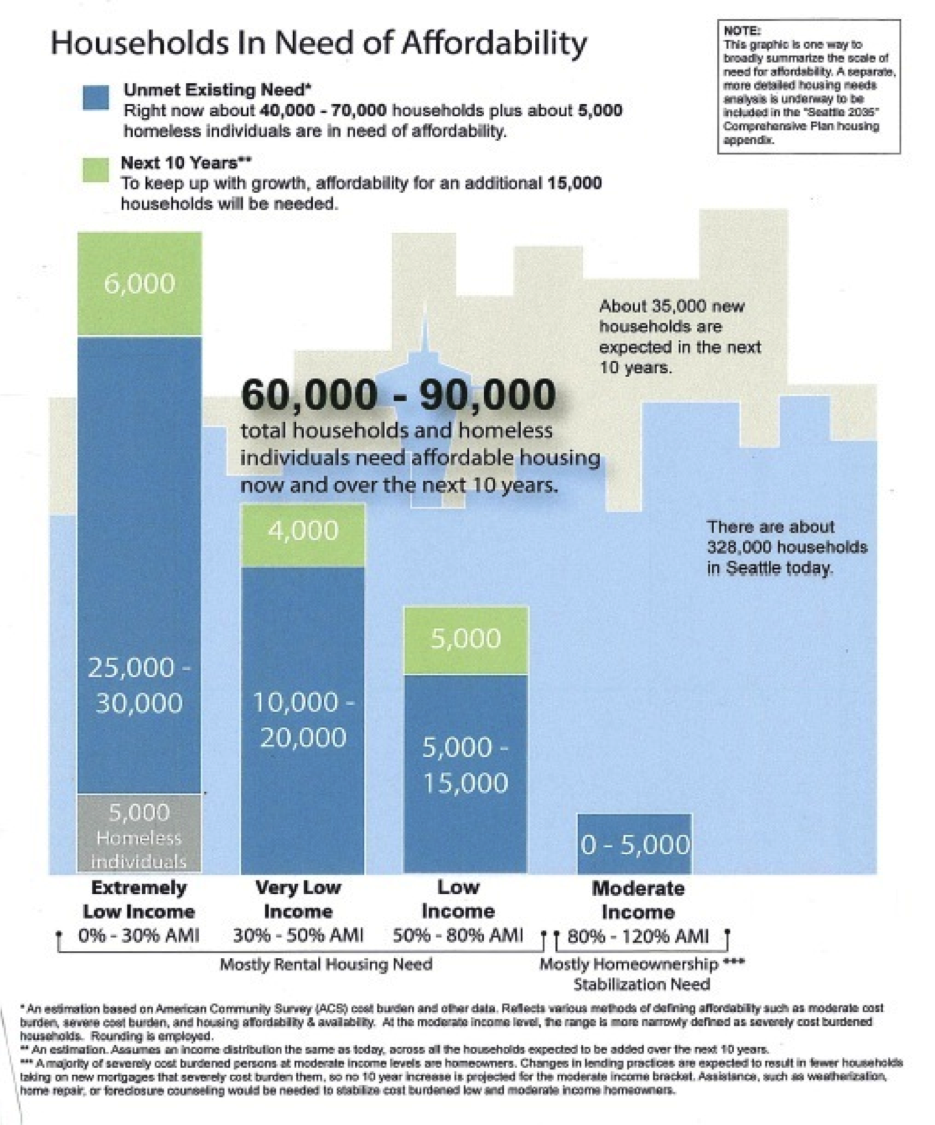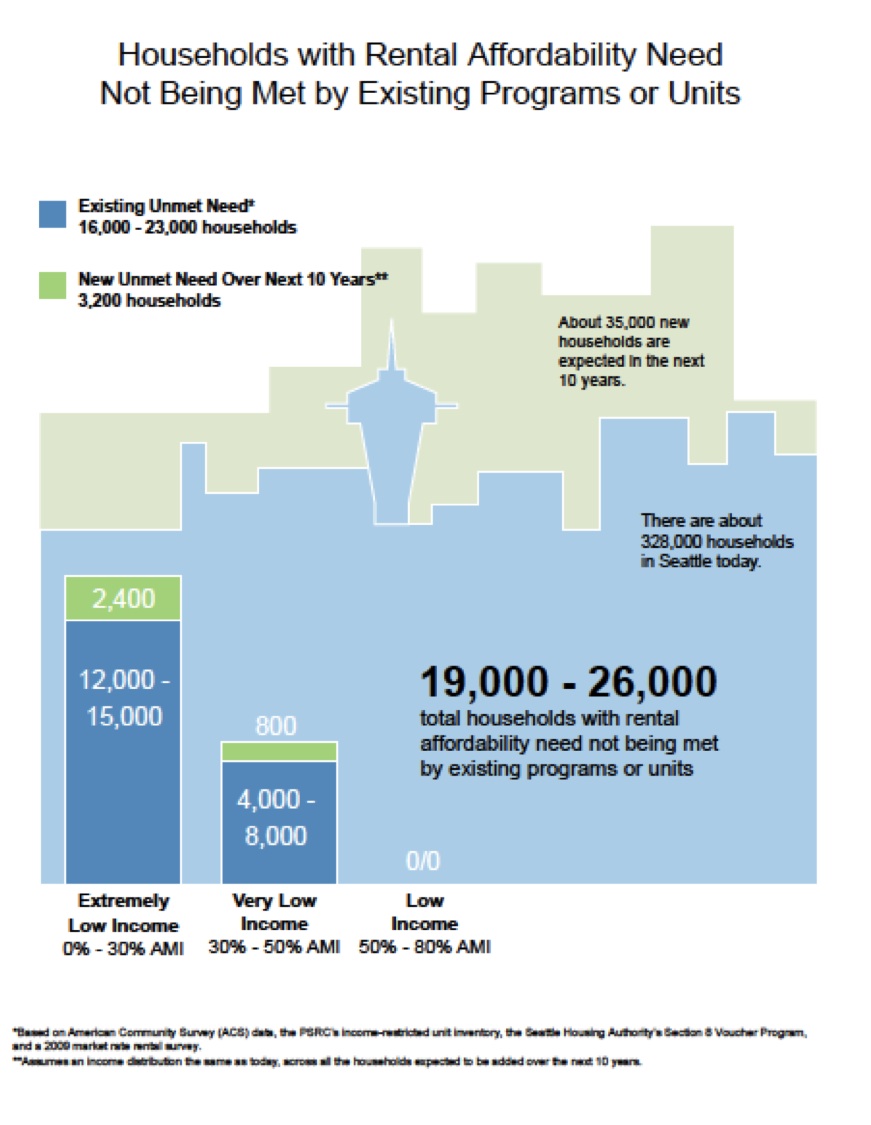Even if Non-Profit Units Cost $50K, It Would Still Make More Sense to Give Away Cash
Well, here I am again with criticism of the Mayor’s proposed supplement to existing voucher programs. The idea, giving vouchers to people struggling with rent in Seattle, is not a bad idea. But as I had suspected, it’s not a simple distribution of cash for rent. In fact, I’m not sure exactly how it will work, but there are three flaws with what I’ve seen so far: bad data, and math. Overall, the housing issue is one of priorities; do we favor quick, efficient solutions, or ones with more red tape and big capital expenditures.
Here’s what I know. The Mayor is in the process of selling a parcel of land in South Lake Union for about $11 million dollars. Out of that sale, she’s going to put $2.2 million into her voucher program. Her first executive order was to set the wheels in motion for the program.
That program is targeted at 149 households that for reasons I don’t understand “are deprioritized in the distribution of Housing Choice Vouchers and will likely not receive a voucher for several years.” These 149 households have annual income between 40 and 50 percent of Area Median Income (AMI) or somewhere between $25,950 and $43,200 per year for a family of three.
Now we don’t know the income of each of these 149 households but if we guess that they average out to the middle range of income 40 percent AMI, or about $34,560 annual income. If that’s the case, and we assume the worst, that the households are paying half their income, then here’s what that would look like for those households every month.
| Annual Income | Monthly Income | Housing Expense (30% of monthly) | Rent Shortfall |
| $34,560 | $2,880 | $864.0 | $536.0 |
So if Durkan’s program would, in fact, just cover the difference, it would cost about $2 million for about two years.
| Monthly Cost | Annual Cost | Two Years |
| $79,864.0 | $958,368.0 | $1,916,736.0 |
I don’t think this is what Durkan is going to do. Based on the first information coming out of the administration, the City isn’t going to cover the difference, although this would make the most sense. Why? Seems like a lot for two years and just 149 households, right?
But let’s consider that these households are already housed somewhere in Seattle, they’re just paying out a lot of their income as rent. It’s driving the non-profit housing people crazy when I say that based on total project costs and units created that their projects cost $500,000 per unit. Fine. Let’s assume it would cost half that to build units for those 149 people. The total cost would be, $37,250,00. And to operate those units for two years would cost, if we assumed a low-end cost of $5,000 per unit, or about $1,490,000.
So, based on the math (and remember I am a philosophy major) just paying down these holds rent with the money from the sale would make much more sense that building them units. A lot more sense because it could be done tomorrow if the bureaucracy wasn’t in the way. It’s doubtful that Durkan’s program will just allow people to submit a rent receipt, a pay stub, and their bank account information; but it should. I’ll say more on that later.
How about the persistent claim by the City cited in the Mayor’s Executive Order about how many households there are between 30 and 50 percent AMI that need help.
WHEREAS, 2014 analysis conducted for the Seattle Housing Affordability and Livability Agenda (HALA) committee found that approximately 10,000 households (renters and owners) earning between 30-50% of AMI are spending more than half of their income on housing costs and are considered severely housing cost burdened
It’s kind of sad to see that cited as if it were fact. For one, notice the nice round edges of that number, unlike the ragged 149 mentioned as the focus of initial resources. We already debunked these numbers back in 2014. Remember these two graphics? The first is what the Mayor is referring to which is wrong, and we created the second as a comparison. The City subsequently abandoned these numbers in the first graphic. It’s like seeing an old friend to have them trotted out again.
You can see before we removed all the available existing resources and housing units (actual rent restricted units created by MFTE, non-profit housing, SHA housing, vouchers etc.) the City was suggesting the number of households that needed some help was between 10,000 and 20,000. When we applied reality to their census numbers from 7 years ago, the number dropped to less than half that figure.
If, and this is a huge if, the number of households needing help in that income band numbered 5,000 and we applied the same math as we did for the 149 households, it would look like this:
| Households | $500 cash per month | For two years |
| 5000 | $2,500,000 | $60,000,000 |
Again, let’s assume a big discount from my cost per unit total that I think is real but feverishly disputed by non-profits; let’s say the cost per unit is only 10 percent of what I have suggested or $50,000 per unit. I’m trusting my calculator here, but the number is $50,000 per units X 5000 households and when I hit this button “=” the number is $250,000,000 excluding annual operating costs. Building 5000 units would take a long time, probably a decade given current production levels of non-profit housing.
Again, the non-profits are Yosemite Sam mad about me exposing the costs of their projects, but the fact is that 88 units at CHIPs 12th Avenue Arts and 112 at El Centro de la Raza’s Beacon Hill project cost a combined total of $92 million dollars. I know that the money is a mix. I know it’s complicated. I know “it doesn’t work like that.”
But leadership, if we had any, would look at the data, the math, and task the bureaucracy to figure out how to get all that money to those households quickly. And that leadership would do that rather than extorting cash from the market, raising market rate housing prices, to create those units way off in the future.
But I’ve got some good news! We’ve already built the website, called helpmewithrent.com. All anyone has to do is put in their income and rent and the calculator kicks out how much money the Mayor could direct deposit to a bank account. Is that going to happen? Well, the next report from the Mayor’s task force is at the end of March. I suppose those households will have to wait until then.




